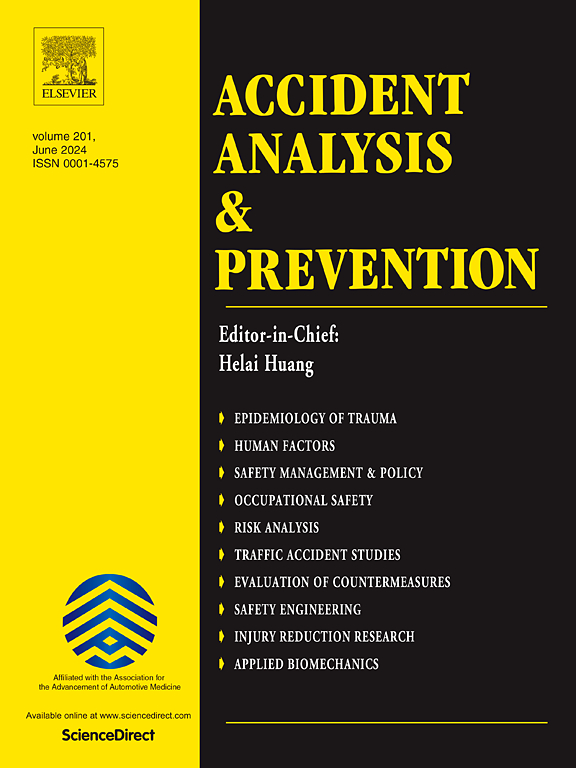A spatial generalized extreme value framework for traffic conflict using max-stable process approach
IF 6.2
1区 工程技术
Q1 ERGONOMICS
引用次数: 0
Abstract
Extreme value theory (EVT) models are widely used to estimate crash risk from traffic conflicts for proactive traffic safety management. However, existing EVT models assume that the crash risks are evenly distributed across the entire study area, ignoring the spatial effect across different zones within the area. This study proposes a spatial EVT modeling framework using max-stable process (MSP) approach for traffic conflicts while accounting for spatial dependence. Traffic conflict data from vehicle trajectories on U.S.101, sourced from the NGSIM dataset, were utilized with time to collision (TTC) as the conflict indicator. Three types of MSP models are used to capture spatial dependence: Schlather, Brown-Resnick, and Smith, each with corresponding correlation functions. Various correlation functions and link functions for each MSP model were proposed. The pairwise composite likelihood estimation approach is utilized to estimate the MSP models’ parameters, and the extremal coefficient indicator is employed to describe the spatial dependence across different zones. Crash risk is estimated for each zone within the study area. Model results show significant spatial correlation in extreme traffic conflicts. Moreover, spatial dependence in these extreme conflicts diminishes with distance, showing stronger correlations at shorter distances. M1 achieved the best goodness-of-fit among the MSP models, indicates that the integration of spatial covariates in the threshold and scale parameters effectively explains a significant amount of variation in the observed data. In particular, the Schlather model with a powered exponential correlation function performs better than the Smith and Brown-Resnick models. The crash risk analysis result shows that inner (fast) lanes have lower crash risk than outer lanes, and crash risk is higher on the entrance ramp than the exit ramp. The crash risk estimated from the spatial EVT model is consistent with the TTC heatmap, particularly in high conflict zones, demonstrating the reliability and validity of the spatial EVT modeling approach for traffic safety analysis.
基于最大稳定过程方法的交通冲突空间广义极值框架
极值理论(EVT)模型被广泛应用于交通冲突碰撞风险的预估,用于主动交通安全管理。然而,现有EVT模型假设碰撞风险在整个研究区域内均匀分布,忽略了区域内不同区域间的空间效应。本研究提出了一种基于最大稳定过程(MSP)方法的交通冲突空间EVT建模框架,同时考虑了空间依赖性。美国101公路上车辆轨迹的交通冲突数据来源于NGSIM数据集,并以碰撞时间(TTC)作为冲突指标。采用Schlather、Brown-Resnick和Smith三种MSP模型来捕捉空间依赖性,每种模型都有相应的相关函数。提出了各MSP模型的相关函数和链接函数。采用两两复合似然估计方法估计MSP模型的参数,采用极值系数指标描述不同区域间的空间相关性。对研究区域内每个区域的碰撞风险进行估计。模型结果表明,极端交通冲突具有显著的空间相关性。此外,这些极端冲突的空间依赖性随着距离的增加而减弱,在较短的距离上表现出更强的相关性。M1在MSP模型中获得了最好的拟合优度,表明阈值和尺度参数中空间协变量的积分有效地解释了观测数据中大量的变化。特别是带幂指数相关函数的Schlather模型优于Smith和Brown-Resnick模型。碰撞风险分析结果表明,内(快)车道的碰撞风险低于外车道,入口匝道的碰撞风险高于出口匝道。空间EVT模型估计的碰撞风险与TTC热图一致,特别是在高冲突地区,证明了空间EVT建模方法用于交通安全分析的可靠性和有效性。
本文章由计算机程序翻译,如有差异,请以英文原文为准。
求助全文
约1分钟内获得全文
求助全文
来源期刊

Accident; analysis and prevention
Multiple-
CiteScore
11.90
自引率
16.90%
发文量
264
审稿时长
48 days
期刊介绍:
Accident Analysis & Prevention provides wide coverage of the general areas relating to accidental injury and damage, including the pre-injury and immediate post-injury phases. Published papers deal with medical, legal, economic, educational, behavioral, theoretical or empirical aspects of transportation accidents, as well as with accidents at other sites. Selected topics within the scope of the Journal may include: studies of human, environmental and vehicular factors influencing the occurrence, type and severity of accidents and injury; the design, implementation and evaluation of countermeasures; biomechanics of impact and human tolerance limits to injury; modelling and statistical analysis of accident data; policy, planning and decision-making in safety.
 求助内容:
求助内容: 应助结果提醒方式:
应助结果提醒方式:


